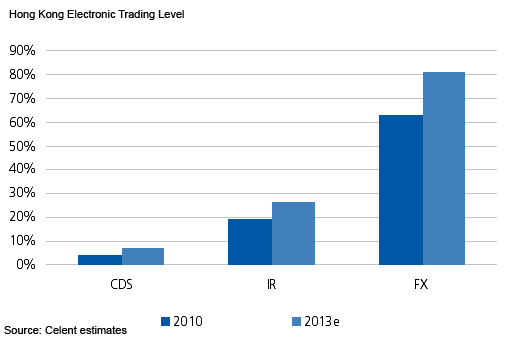Electronic Trading Levels in Hong Kong’s OTC Markets
Abstract
In 2010, Hong Kong was the sixth largest FX market in the world and the third largest in Asia. There are a number of trading platforms operating in Hong Kong, such as ABP (Asia Bond Portal), BIA (Bond in Asia), and FXall.
In a new report, OTC Derivatives and Trading Platforms in Hong Kong, Celent examines the regulation dynamics in Hong Kong as well as the market size, trends in the OTC derivatives market, participant trends, electronic trading, and trading platforms. The most recent survey shows that interest rate swaps (IRS) represent over 73% of interest rate derivative transactions in Hong Kong, with about US$1.3 billion in daily turnover. As regulations change the credit landscape, the market continues to shift towards a model that is increasingly standardized and therefore rooted in electronic trading.

Some OTC trading platform providers launched new services in 2011, and some trading may be moved to exchanges. The HKEx is making preparations for the launch of RMB NDFs and IRS clearing by setting up a new OTC clearing house independent of its existing houses. Thomson Reuters, Deutsche Bank, and Standard Chartered launched their own RMB-related derivatives trading platforms in 2011.
“Many factors show that RMB-related derivatives will grow significantly,” says Hua Zhang, analyst with Celent’s Asian Financial Services group and author of the report, “However, the market size will be very small in the near future, because of few outstanding RMB assets.”
The current RMB settlement rate in the international trade is very small, at only around 7%. The daily spot RMB trading will reach US$1.8 billion in 2011 and $3 billion before 2014, while daily RMB FX swaps trading reached $0.3 billion in 2010, and will reach $0.5 billion in 2011.

